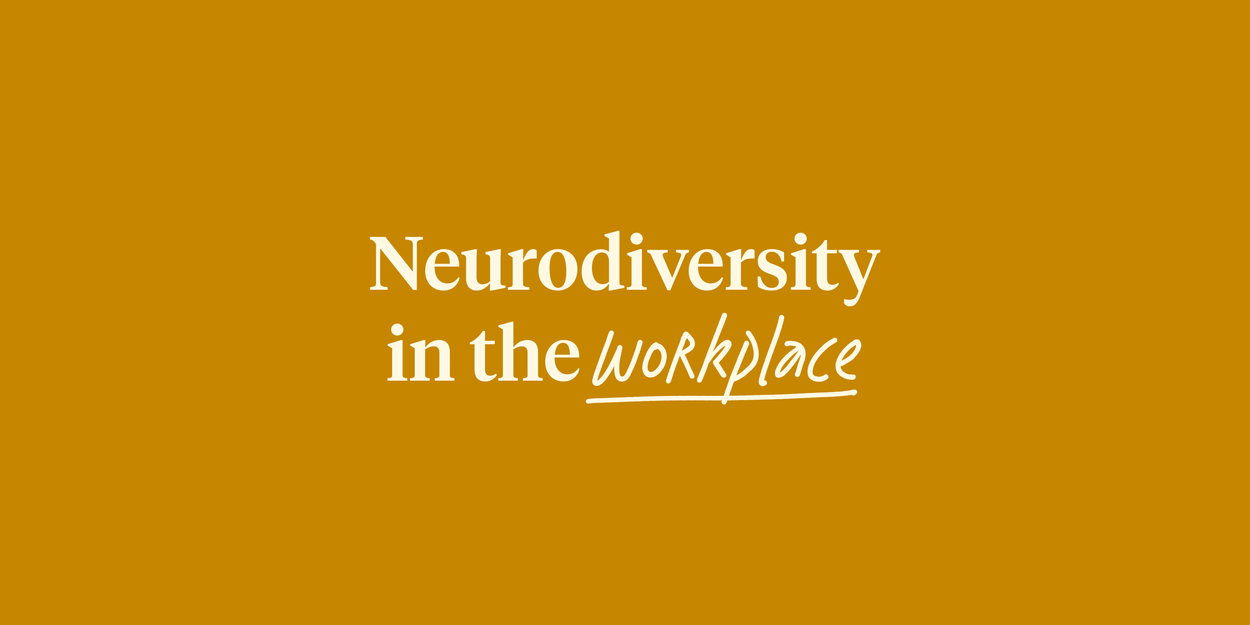
Neurodiversity in the workplace: Why it matters

Written by

Senior Content Marketing Manager, Culture Amp
As you may notice, this article combines the idea of disability and neurodiversity. While there is debate within the disability community as to whether neurodiversity constitutes a disability, we’ve chosen to use these terms together in this article. That said, you should always defer to an individual’s preferences.
Does your definition of workplace diversity include disability? And does it go beyond physical disabilities to also include neurodiversity?
The answer for most organizations is likely “no.”
Studies estimate that the unemployment rate for neurodiverse adults runs as high as 30-40%, which is three times higher than the rate for disabled people, and eight times higher than the rate for people without disabilities. A survey of Fortune 500 companies found that while 90% of respondents responded affirmatively to hiring applicants with physical disabilities or hearing impairments, only 20% responded affirmatively to hiring applicants with severe mental disabilities.
This is despite the numerous strengths and skills that neurodiverse talent brings to their communities and organizations. So what exactly is “neurodiversity,” and why does it make sense for organizations to embrace neurodiversity in the workplace?
Defining neurodiversity
Let’s begin by defining neurodiversity, neurodivergent, neurotypical, and neurodiverse:
- Neurodiversity refers to the natural variations in how the brain processes and interprets information. It describes the idea that there is no one “right” way of experiencing and interacting with the world and that cognitive differences shouldn’t be viewed as deficient but embraced as an inherent part of human diversity.
- Neurodivergent describes an individual with cognitive differences.
- Neurotypical describes an individual with a brain that functions in a typical way that more neatly “fits into” mainstream society.
- Neurodiverse is used to describe a group of people who are neurodivergent.
Types of neurodiversity
Although “neurodiversity” is a state in which all people exist somewhere on the spectrum, it’s often used to describe individuals with certain neurological or developmental differences and/or learning disabilities. These may include:
- Attention deficit hyperactive disorder (ADHD)
- Autism
- Bipolar disorder
- Dyslexia
- Dyspraxia
- Dyscalculia
- Epilepsy
- Obsessive-compulsive disorder
- Tourette syndrome
- Trauma
- Sensory integration disorder
Is neurodiversity a disability?
If we want to answer the question, “Is neurodiversity a disability?” we must first understand that at a literal level, neurodiversity and disability are not trying to describe the same thing.
While “neurodiversity” describes a natural spectrum of differences (like biodiversity), “disability” describes a physical or mental impairment that limits an individual from one or more major life activities.
Thus, not every neurodivergent person is disabled, in the same way that not every disabled person is neurodivergent. And while the debate is divided and highly controversial, especially within the autism community, it’s generally agreed that there are individuals along the spectrum of neurodiversity who also have a disability. For example, some individuals with neurodivergent conditions may experience significant challenges that can impact their ability to function in certain environments, such as if they are nonverbal or experience significant learning difficulties.
All this being said, we’d like to reemphasize the fact that the disability/neurodiversity conversation is controversial and nuanced. Nonetheless, you should always defer to what somebody prefers to identify as, whether it’s neurodivergent, disabled, or both*.
*Be aware of the legal definition of disability in your region: In some countries, like the U.K., neurodiversity is a protected characteristic covered under the Disability Act. Although some neurodiverse individuals may not identify as disabled, they may still qualify for legal protections. Keep local laws and regulations in mind as you design and communicate policies related to neurodiversity and disability in your organization.
Benefits of neurodiversity in the workplace
Neurodivergent employees aren’t just positive additions to the workplace but a proven competitive advantage. Neurodivergent individuals have been found to possess some of the most sought skills in today’s world of work, including:
- Greater than normal ability to process information. Research has found that autistic employees “have a greater than normal capacity for processing information even from rapid presentations and are better able to detect information defined as ‘critical.’”
- Creative thinking. Many of the symptoms of ADHD – creativity, risk-seeking, high energy, and the desire to multitask – can become key strengths when leveraged the right way, in the right job, and in the right organization. Meanwhile, individuals with dyslexia are “often capable of seeing connections that others cannot and create narrations which can simplify complex tasks or products.”
- Elevated productivity. A case study by JPMorgan Chase found that professionals in its Autism at Work initiative made fewer errors and were 90% to 140% more productive than neurotypical employees.
- Ability to take a different perspective. Because neurodiverse people are “wired” differently from neurotypical people, they often bring innovative ways of thinking and problem-solving to their teams and organizations.
🔔 Reminder: The list above is far from exhaustive, and not every neurodivergent individual will exhibit all or any of those specific qualities. Every person is unique, neurodivergent or not. Organizations must avoid hiring neurodiverse employees expecting them to, for example, fit the stereotype of an “autistic savant” who exhibits exceptional, genius-level abilities in one or more domains.
Moreover, prioritizing neurodiversity in the workplace also significantly benefits key business metrics like:
- Team productivity and performance. According to a Deloitte report, “research suggests that teams with neurodivergent professionals in some roles can be 30% more productive than those without them.” This is likely because of neurodiverse employees’ unique skills and cognitive abilities, allowing them to solve problems and approach tasks differently than their team members.
- Retention. Given that the company is supportive and inclusive, neurodiverse employees are generally quite loyal and have significantly lower turnover rates than neurotypical employees. EY, SAP, JPMorgan Chase, and Microsoft – which run four of the largest U.S. autism hiring programs – report a retention rate of more than 90%.
- Engagement. Employees generally feel more engaged at workplaces with a strong sense of inclusion and belonging. As a result, hiring neurodiverse employees can improve employees’ perceptions of DEI and company culture, which in turn helps boost employee engagement. Organizations that have implemented programs targeting neurodiversity found that neurotypical employees who work in areas of the business that neurodiversity programs touch felt that “involvement makes their work more meaningful and their morale higher.”
- Innovation. Because they think differently from their neurotypical peers, neurodiverse employees can help drive innovation among their teams. As a matter of fact, SAP reported one of their neurodivergent employees developed a technical fix that saved the company an estimated $40 million.
- Talent attraction. A 2022 Glassdoor study found that DEI “matters for the majority of employees and job seekers across age groups, but it matters more for younger employees, women, and people of color.” As a key aspect of diversity, prioritizing neurodiversity is essential for companies hoping to attract the next generation of talent.
Aubrey Blanche, Senior Director of People Operations & Strategic Programs at Culture Amp, agrees. She explains, “Given that up to 30% of the population is considered to be neurodivergent, it’s an almost indefensible talent strategy to not consider the needs of these populations in your workplace. The fact is, it’s not only the right thing to do for people, it’s the right thing to do for the business.”
Given that up to 30% of the population is considered to be neurodivergent, it’s an almost indefensible talent strategy to not consider the needs of these populations in your workplace.
Aubrey Blanche
Senior Director of People Operations & Strategic Programs at Culture Amp
Neurodiversity: Barriers to employment and retention
Despite all the benefits that neurodiversity brings to the workplace, neurodiverse individuals often face huge obstacles in entering and remaining in the workplace.
In the webinar, “Neurodiversity - Creating an inclusive workplace,” Stephanie Kukoyi, Senior People Scientist at Culture Amp, points out three interconnected barriers:
-
Culture
All employees thrive in cultures with a strong sense of belonging and psychological safety, but these factors are especially important to neurodiverse employees. Stephanie explains, “If a neurodivergent employee feels like they may be negatively treated due to the culture of the organization, they’re less likely to disclose their condition in the first place, or to seek the support they need to be successful.”
That’s why hiring and retaining neurodiverse employees requires actively working with neurotypical employees to understand and mitigate the many unconscious biases and microaggressions that the neurodivergent community faces. Talent teams must be especially cognizant of any biases they may have against neurodiverse employees as they head into the interview process, and build in processes to ensure equitable and inclusive hiring practices. -
Lack of access to reasonable accommodations and adjustments
Reasonable accommodations or adjustments describe any changes in the workplace resources provided, or the way job duties are customarily performed, in order to provide an equal employment opportunity to an individual with a disability.
Although reasonable accommodations are required by law in many places, many neurodiverse employees struggle to access these resources. There are many reasons for this, including difficulty accessing information, fear of needing to disclose their disability, or employers’ lack of willingness.
This poses a huge obstacle for the neurodiverse community, as “lack of accessibility disadvantages neurodiverse employees in completing their tasks, and also in progressing at the organization.” For some in the neurodiverse community, accommodations or adjustments are necessary to perform their jobs at all. -
Lack of access to learning and development
Culture Amp research has consistently found that lack of learning and development opportunities is the top reason employees leave their companies. This likely holds true for neurodivergent employees.
Unfortunately, not all organizations provide the support and tools neurodiverse employees need to equitably access learning and development opportunities. This is supported by a survey by Texthelp, which found that 64% of neurodivergent employees believe their organization could be doing more to support people with a neurodivergent condition. Many neurodivergent employees learn differently than neurotypical employees, which means that generic L&D tools and programs may provide minimal to no growth.
Create an inclusive workplace where everyone can thrive
Neurodiversity is a powerful yet often overlooked form of diversity. Prioritizing and embracing neurodiversity inclusion in the workplace isn’t just the right thing to do – it’s the smart thing to do as a business.
Below, we share a few tips for building a more equitable, neurodiversity-inclusive world of work:
- Start an employee resource group. Employee resource groups (also known as ERGs or affinity groups) are voluntary, identity-based communities intended to provide a safe space for people from marginalized communities to come together. At Culture Amp, neurodiverse employees can join Camp ID (Inclusive Disabilities), which was created to amplify the voices of employees living with visible and invisible disabilities.
- Make information about accommodations openly and easily accessible. Ideally, this information is incorporated into the onboarding process to ensure that all new employees know that accommodations are available, and where they can get information about the accommodations process. Even better, provide employees with examples of what accommodations could look like, such as a flexible schedule, noise-canceling headphones, extra time to complete work or take breaks, and having all video meetings recorded and closed-captioned.
- Embrace flexibility. Everyone benefits from flexibility – not just neurodivergent employees. The fact of the matter is that flexibility looks different for everyone. In many ways, flexibility goes hand-in-hand with the accommodations process. To create a workplace that truly empowers neurodiverse employees to thrive, leaders need to be open-minded to the various ways people prefer to work.
- Encourage all employees to develop “user manuals.” Provide the opportunity and structure for every employee to share their preferred ways of working. By normalizing the providing of specific instructions for how to collaborate, you’ll ensure that all of your team members work together more effectively.
Last but not least, educate yourself and others about neurodiversity. Neurotypical employees may have misconceptions about what neurodiverse employees are like, or feel unsure about how to work alongside a neurodivergent coworker. However, neurodiversity is simply another spectrum of natural human differences. Only by normalizing the conversation around neurodiversity can we begin to change it.
The journey toward becoming a truly diverse, equitable, and inclusive workplace is long, but a commitment to meaningful action is the only way to achieve change.


